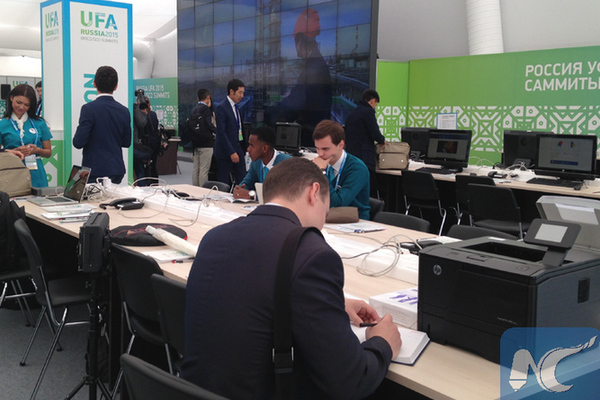BRICS on right path to overcoming economic woes
 0 Comment(s)
0 Comment(s) Print
Print E-mail Xinhua, July 8, 2015
E-mail Xinhua, July 8, 2015
|
|
|
Journalists are seen working at the media center ahead of the BRICS and SCO summits in Ufa, Russia on July 7, 2015. (Xinhua/Photo) |
As pessimists question whether the BRICS economies are losing steam, the group’s different countries are taking concrete steps to ensure their respective futures.
The New Development Bank, expected to be launched late this year or early next year in Shanghai, testifies to their endeavors. More importantly, Brazil, Russia, India, China and South Africa are showing a coordinated attitude toward the reform of global economic governance that has historically been dominated by Europe and the United States.
The NDB’s board of governors yesterday held its first meeting in Moscow to appoint members to the board of directors and the management. The meeting is a prelude to the July 8-9 summit of leaders of the five countries in the southwestern Russian city of Ufa. Another financial tool, the BRICS Contingent Reserve Arrangement, will also be discussed at the summit, the bloc’s seventh since 2009.
The economic outlook for the BRICS countries this year is not as rosy as it was two or three years ago. But is it true, that the bloc has lost its luster and even slowed down the world economy?
Given their contributions to the global recovery since the 2008 financial crisis, it is unfair to say so based only on the past six months.
The five economies have combined to produce more than half the world’s economic growth over the past decade. In fact, the bloc as a whole remains the engine of world economic growth. All five nations are carrying out structural reforms to create balanced, sustainable growth in order to unlock domestic demand.
Take China as an example. Its economy grew 7.4 percent in 2014, its slowest rate in 24 years. However, the central government focused on creating higher-quality and innovation-driven growth. The World Bank found that overcapacity in heavy industries, decelerating exports and regulatory tightening of nontraditional lending had constrained the economy. But it also found that growth in services remains robust, especially in advanced services such as banking and insurance. In recent years consumption has grown slightly faster than investment.
Within the BRICS framework, economic ties have improved over the past six years since the bloc’s first summit was held. Trade among BRICS nations in 2013 totaled US$350 billion, 2.5 times the value six years ago. China is now the largest trading partner of Brazil, Russia and South Africa, and India’s second-largest trading partner.
At the end of last year, China’s accumulative investment in the other four countries exceeded US$55 billion.
The five nations, with 42.6 percent of the world’s total population and roughly one third of the world’s land area, have a combined GDP accounting for about one fifth of the world total. Each country has its own comparative advantages, including human and natural resources.
Imagine the potential if these nations work together. Fortunately, they are already on the right path to overcoming economic hardships and the Ufa summit will further show the world their progress. And here’s the advice for the BRICS: Stay focused on building an influential platform that can be a model for all emerging economies.







Go to Forum >>0 Comment(s)